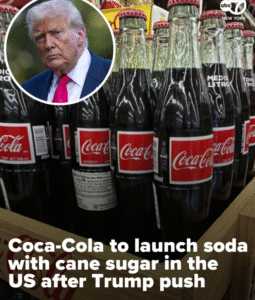Coca-Cola has officially confirmed that a cane-sugar version of its iconic cola will be launched in the United States this fall. This announcement marks a significant moment for fans of the brand who have long sought a version of Coke made with cane sugar rather than high fructose corn syrup, which has been the primary sweetener in the U.S. for decades.
The cane-sugar version is expected to closely resemble the original taste of Coca-Cola as it was first introduced, delivering a nostalgic flavor profile that many consumers remember from earlier days or from international markets where cane sugar is still commonly used. This move aligns with a growing consumer demand for products perceived as more natural or authentic, especially when it comes to sweeteners.
For years, Coca-Cola has offered cane sugar versions of its product in various countries, including Mexico, where “Mexican Coke” is highly popular and often imported by U.S. customers craving its distinct taste. The success and popularity of these versions abroad have likely influenced the decision to introduce a cane-sugar Coca-Cola domestically.
The introduction of this new formula is expected to appeal to a broad range of consumers—from longtime Coke enthusiasts seeking a return to traditional flavors to younger buyers interested in premium or craft beverages with simpler ingredient lists. It may also resonate with people concerned about the health impacts of high fructose corn syrup or those who simply prefer the taste of cane sugar.
Coca-Cola’s decision comes amid a broader trend in the beverage industry towards offering more transparent, ingredient-focused options. Many companies are reformulating or launching new products that highlight natural ingredients, cleaner labels, and classic recipes. The cane-sugar Coke fits neatly into this evolving landscape.
While the packaging and branding for the cane-sugar Coca-Cola have not been fully detailed, it is anticipated that the product will be clearly distinguished from the standard formula to help consumers make informed choices. Retailers will likely carry this version alongside existing Coca-Cola products, providing a new option on store shelves.
Industry analysts suggest that this launch could reinvigorate the cola market segment by capturing nostalgic buyers as well as new customers seeking authenticity. It also opens potential for Coca-Cola to expand its portfolio with other variations that cater to specific tastes and preferences.
Marketing efforts are expected to emphasize the heritage and craftsmanship behind the cane-sugar version, possibly drawing on the brand’s rich history and connection to classic Americana. The campaign may also highlight the sourcing of cane sugar and the sensory experience of the beverage’s flavor and mouthfeel.
Consumers looking forward to this release can anticipate availability in various formats, including cans and bottles, and possibly in both regular and diet or zero-sugar varieties, depending on how Coca-Cola chooses to extend the offering.
Overall, the launch of a cane-sugar Coca-Cola in the U.S. signals a significant nod to consumer preferences and the evolving landscape of sweetened beverages. It reflects a balance between tradition and innovation, offering a product that honors the brand’s legacy while responding to contemporary demands.
As the fall release approaches, excitement is building among soda lovers eager to taste this nostalgic version. Whether this new product will become a permanent staple or a limited-edition offering remains to be seen, but its arrival certainly adds a fresh chapter to Coca-Cola’s long and storied history.
In summary, Coca-Cola’s introduction of a cane-sugar version in the U.S. market this fall represents a strategic move to reconnect with traditional flavors, appeal to health-conscious and ingredient-aware consumers, and capitalize on a trend toward more natural product formulations. It promises to offer an alternative for those who have missed the original taste and opens new opportunities for growth in the highly competitive beverage industry.


